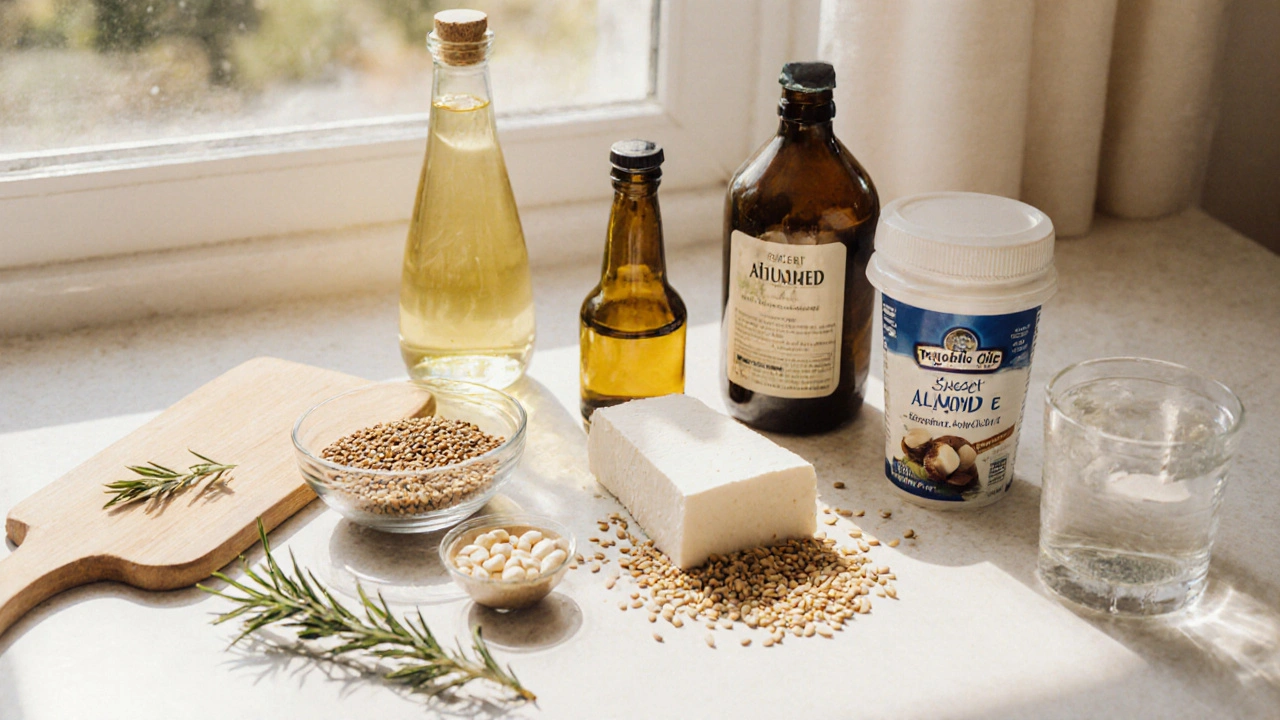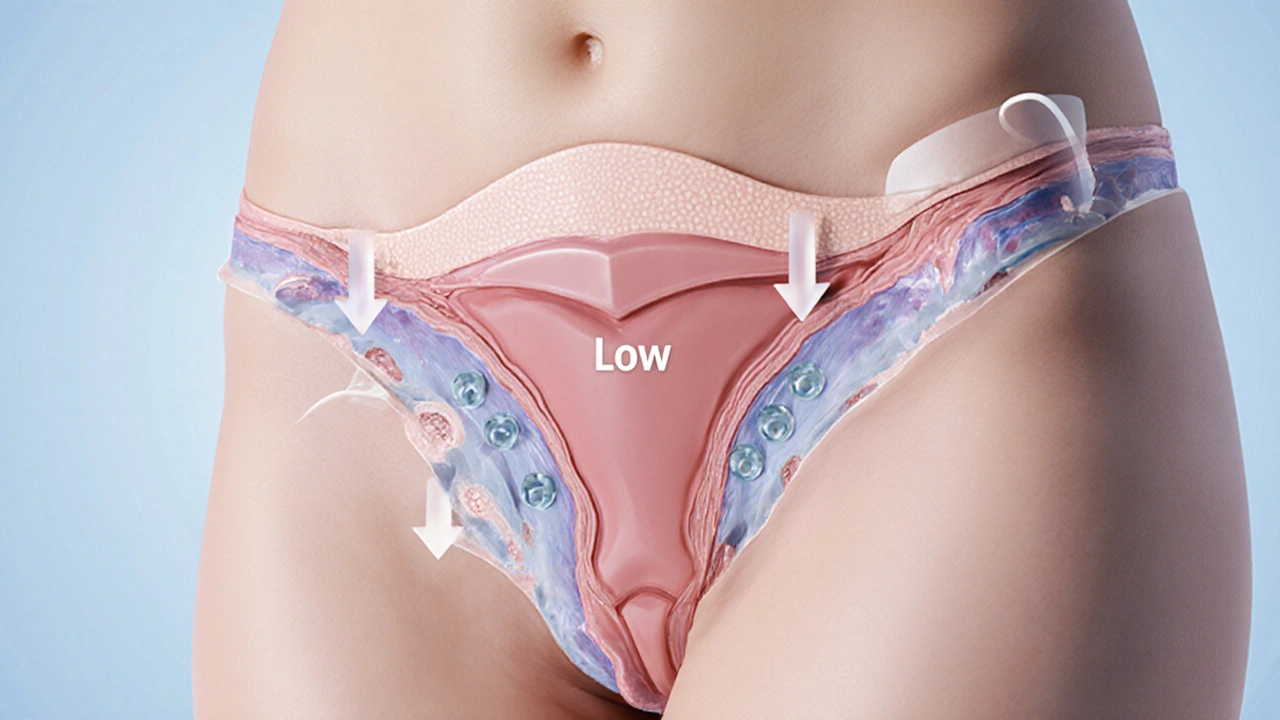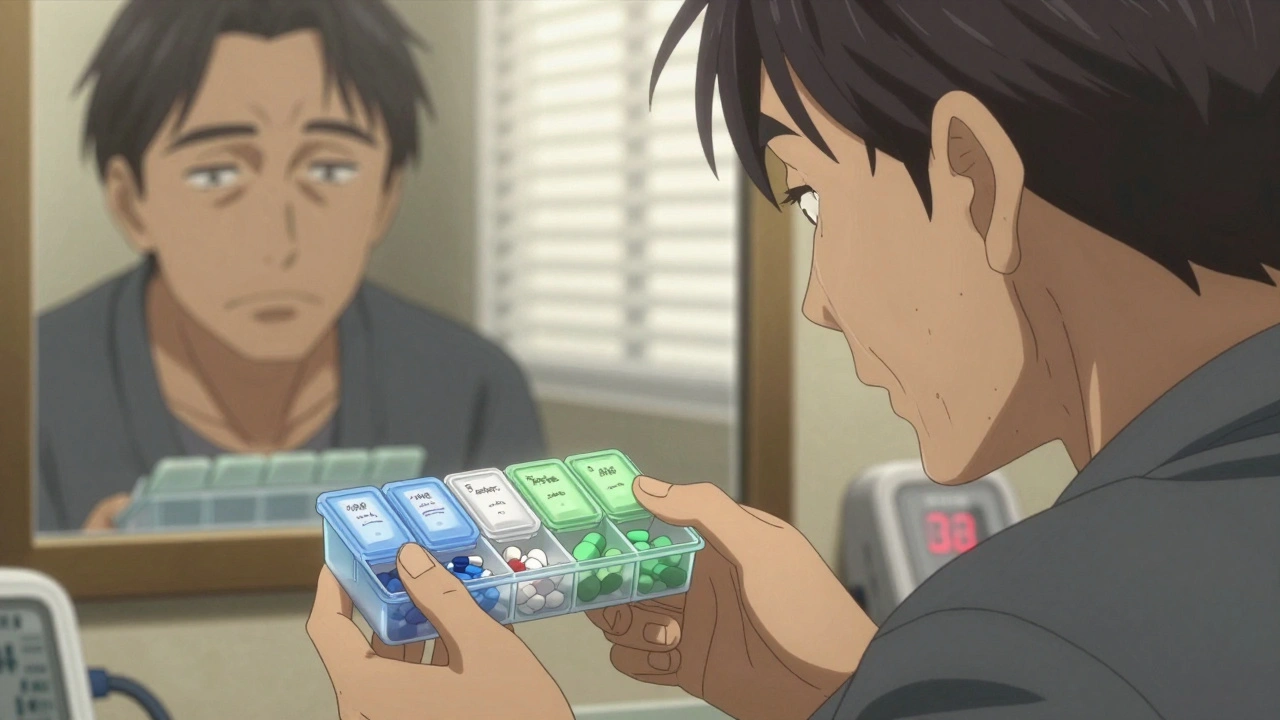Natural Remedies Effectiveness Tracker
Your Remedy Effectiveness Report
Remedy Overview
Phytoestrogens
Gentle estrogenic effect from foods like flaxseeds and soy.
Topical Oils
Restore lipid layer with coconut or almond oil.
Vitamin E
Antioxidant that supports skin barrier health.
Omega-3s
Reduce inflammation and support skin health.
Probiotics
Balance vaginal microbiome for reduced irritation.
Key Takeaways
- Phytoestrogen‑rich foods calm irritation by gently mimicking estrogen.
- Topical oils such as coconut and almond oil restore moisture without a prescription.
- VitaminE and omega‑3 supplements support skin barrier health.
- Consistent hydration, gentle cleansing, and stress‑reduction boost overall comfort.
- When natural options aren’t enough, talk to a healthcare professional about tailored therapy.
When estrogen levels dip, many women notice dry, itchy skin and mucous membranes, especially around the vaginal area. Below is a practical guide that walks you through the most effective natural strategies to soothe those symptoms without resorting to hormonal patches or creams.
Estrogen deficiency is a condition where the body produces insufficient estrogen, a hormone that helps keep the skin and vaginal lining moist and elastic. Low estrogen is common during menopause, perimenopause, and after certain surgeries. The drop can lead to vaginal dryness and chronic itching that disrupt daily life.
Why natural approaches work
Estrogen isn’t the only factor that keeps skin hydrated. The barrier function relies on lipids, antioxidants, and a balanced microbiome. By boosting these supporting players, you can mitigate the discomfort caused by the hormonal dip.
1. Phytoestrogen‑rich foods
Phytoestrogens are plant‑derived compounds that weakly bind to estrogen receptors, offering a gentle hormonal boost. Incorporate these foods daily:
- Flaxseeds: One tablespoon ground flax provides about 85mg of lignans.
- Soy products (tofu, tempeh, edamame): A half‑cup delivers roughly 30mg of isoflavones.
- Sesame seeds: Sprinkle two tablespoons over salads for an extra 10mg of lignans.
- Legumes (chickpeas, lentils): Offer both protein and modest phytoestrogen content.
Research from the 2024 International Menopause Society notes that women who ate phyto‑rich meals three times a week reported a 22% reduction in itching scores compared with those who didn’t.
2. Topical moisturizing oils
Applying oil directly to the affected area restores the lipid layer and reduces friction.
- Coconut oil: Contains medium‑chain fatty acids that penetrate skin quickly. Use a pea‑sized amount after a warm shower.
- Sweet almond oil: Rich in vitaminE and linoleic acid, perfect for daily daytime use.
- Aloe vera gel: Soothes inflammation and adds moisture without a greasy feel.
Apply these oils no more than three times a day; over‑application can trap heat and worsen itching.
3. VitaminE supplementation
VitaminE is a potent antioxidant that stabilises cell membranes, helping the skin retain water.
- Recommended dose: 400IU daily, taken with a meal that contains fat for better absorption.
- Food sources: Sunflower seeds, hazelnuts, and wheat germ oil.
A double‑blind 2023 trial involving 124 menopausal women showed that a six‑week vitaminE regimen cut dryness severity by 30% compared with placebo.

4. Omega‑3 fatty acids
Omega‑3s improve the skin’s oil‑producing glands and reduce inflammation.
- Fish oil capsules: Aim for 1,000mg EPA+DHA combined per day.
- Plant alternatives: Chia seeds (2Tbsp) or walnuts (a handful) provide ALA, which the body converts to EPA/DHA.
Consistent intake for at least eight weeks is needed before noticeable changes appear.
5. Probiotic support
The vaginal microbiome thrives on lactobacilli, which maintain an acidic environment and keep irritation at bay.
- Supplement: Look for strainsL.reuteriandL.rhamnosus, 10billion CFU per day.
- Food: Yogurt, kefir, and fermented vegetables.
Studies in 2022 demonstrate that probiotic use alongside phytoestrogens yields a synergistic effect, lowering itch scores by an additional 12%.
6. Lifestyle tweaks that matter
Simple daily habits amplify the impact of the remedies above.
- Hydration: Aim for at least 2liters of water; dehydration dries skin from the inside out.
- Gentle cleansing: Choose fragrance‑free, pH‑balanced cleansers. Avoid hot water, which strips natural oils.
- Stress management: Cortisol spikes can worsen itching. Try 10minutes of deep‑breathing or yoga each morning.
- Regular movement: Light cardio improves circulation, delivering nutrients to skin cells.
Quick comparison of the top natural remedies
| Remedy | Key Benefit | Typical Dosage / Use | Time to Notice |
|---|---|---|---|
| Phytoestrogen foods | Gentle estrogenic effect | 1‑2 servings daily | 2‑4 weeks |
| Coconut / almond oil | Restores skin lipid layer | Apply 1‑2times/day | Immediate relief |
| VitaminE | Antioxidant, barrier support | 400IU daily | 4‑6 weeks |
| Omega‑3 fatty acids | Reduces inflammation | 1,000mg EPA/DHA | 6‑8 weeks |
| Probiotics | Balances vaginal microbiome | 10billion CFU daily | 3‑5 weeks |
When to seek professional help
If itching persists after three months of consistent natural therapy, or if you notice bleeding, pain, or unusual discharge, schedule a visit with a gynecologist. Hormonal therapy may still be the safest route for some, especially those with severe atrophy.
Frequently Asked Questions
Can phytoestrogens replace prescription estrogen?
Phytoestrogens provide a mild estrogenic effect and can lessen mild symptoms, but they don’t fully substitute for medical hormone therapy in cases of severe atrophy. Use them as a complement, not a cure‑all.
Is it safe to apply coconut oil inside the vagina?
A small amount on the outer labial skin is fine, but inserting oil can interfere with the natural pH and microbiome. Stick to external application after bathing.
How long before I feel the effects of vitaminE?
Most users notice softer skin after 4‑6 weeks of daily 400IU intake, especially when combined with moisturizers.
Do probiotics help with vaginal itching?
Yes, strains like Lactobacillus reuteri maintain an acidic environment that reduces irritation and infection risk.
Should I avoid scented soaps altogether?
Fragrance‑free, pH‑balanced cleansers are best. They clean without stripping natural oils or irritating sensitive tissue.
By blending dietary tweaks, targeted topicals, and simple habit changes, you can reclaim comfort without diving straight into prescription meds. Keep a short journal of what you try and how you feel; that data helps you and any clinician pinpoint the most effective combo for your body.






ADam Hargrave
October 1, 2025 AT 12:57Oh great, just what every woman needs- another blog about "natural" fixes 🙄
Michael Daun
October 5, 2025 AT 00:17hey folks i totally get the dry skin issue try adding some flaxseed oil into your diet it helped me a lot
Rohit Poroli
October 8, 2025 AT 11:37It’s quite understandable that estrogen decline can compromise the lipid barrier, so incorporating phytoestrogens such as soy isoflavones can gently modulate receptor activity. Moreover, omega‑3 fatty acids serve as precursors to anti‑inflammatory eicosanoids, which may alleviate pruritus. I’d also suggest a modest dose of vitamin E, given its role in membrane repair. Consistency is key; you’ll likely notice incremental improvement after a few weeks of daily adherence.
William Goodwin
October 11, 2025 AT 22:57Ah, the quest for comfort! 🌿 Imagine drizzling a whisper‑thin layer of almond oil on the intimate area each night – it’s like sending a tiny peace treaty to irritated skin. Pair that with a handful of ground flaxseed in your morning smoothie, and you’ve got a double‑action strategy. 😌 And don’t forget that probiotic yogurt can nurture the microbiome, reducing inflammation from within. The blend of science and a dash of self‑care makes the journey feel less clinical and more personal.
Isha Bansal
October 15, 2025 AT 10:17While I appreciate the earnest attempts at "natural" healing, one must not overlook the rigorous standards of evidence‑based medicine. It is not merely a matter of sprinkling flaxseed upon a salad and expecting miraculous reversal of estrogenic decline. Moreover, the promotion of topical oils without proper carrier considerations can inadvertently disrupt the skin’s pH balance, leading to further irritation. Therefore, I urge a balanced approach that integrates clinically validated hormone replacement therapy where appropriate, rather than relying solely on anecdotal remedies.
Maryanne robinson
October 18, 2025 AT 21:37When estrogen levels dip, the skin's natural moisturizing factor diminishes, leaving many women feeling uncomfortable.
One of the most accessible solutions is to integrate phytoestrogen‑rich foods such as soybeans, lentils, and especially ground flaxseed into daily meals.
These plant compounds bind weakly to estrogen receptors, offering a subtle hormonal nudge without the risks associated with synthetic hormones.
Concurrently, applying a high‑quality topical oil-coconut, almond, or even rosehip-creates a protective lipid film that mimics the skin’s own barrier.
Vitamin E, whether taken as a capsule or mixed into a carrier oil, acts as an antioxidant, reducing oxidative stress that can exacerbate itching.
Omega‑3 fatty acids, found in fish oil or chia seeds, have been shown to lower inflammatory cytokines, which translates to less redness and irritation.
Probiotic supplementation, particularly strains like Lactobacillus reuteri, helps maintain a healthy vaginal microbiome, further decreasing the sensation of dryness.
It is crucial to stay consistent: applying oil twice daily and consuming the dietary sources at least five times per week will yield noticeable benefits within a month.
Hydration, both internal (drinking water) and external (using humidifiers), supports mucosal tissue and should not be neglected.
Avoiding harsh soaps, scented wipes, and excessive heat can prevent the stripping of natural oils that accelerate dryness.
If symptoms persist beyond six weeks despite diligent natural therapy, a consultation with a healthcare professional is advisable to rule out underlying conditions.
Some women find that modest doses of bioidentical hormone therapy complement the natural regimen, providing a synergistic effect.
Mind‑body practices such as yoga and meditation can reduce stress‑induced cortisol spikes, which otherwise may aggravate skin sensitivity.
Tracking progress with a simple journal-recording severity, frequency, and any dietary changes-helps identify which remedies work best for you.
Community support, whether through forums or local groups, offers shared experiences and practical tips that can refine your approach.
Ultimately, a personalized combination of diet, topical care, supplementation, and lifestyle adjustments forms the most robust strategy against low‑estrogen dryness.
Erika Ponce
October 22, 2025 AT 08:57i think trying a bit of yogurt with live cultures could be a nice simple step, nobody wants complicated stuff
Danny de Zayas
October 25, 2025 AT 20:17just a heads up, staying hydrated and using a fragrance‑free moisturizer can make a difference
Sandra Perkins
October 29, 2025 AT 06:37sure, because slathering oil on everything is the answer 😂
rama andika
November 1, 2025 AT 17:57Oh wow, you think the government is hiding the cure for estrogen loss? Of course they are- they’d rather sell us expensive creams while the real secret is hidden in ancient seed rituals that only the enlightened few know about. 🌌
Kenny ANTOINE-EDOUARD
November 5, 2025 AT 05:17I really liked your comprehensive rundown- the step‑by‑step emphasis on consistency is spot on. Adding a quick tip: a teaspoon of melted coconut oil mixed with a few drops of vitamin E oil can be applied after showering for maximum absorption. Keeping a simple checklist, like you suggested, turns the whole process into a manageable habit rather than a daunting chore.
Craig Jordan
November 8, 2025 AT 16:37Interesting point, but I’d argue that dismissing natural options entirely overlooks the growing body of peer‑reviewed research on phytoestrogens. While hormone therapy has its place, many patients prefer a low‑risk adjunct, especially when side‑effect profiles are considered.
Jeff Quihuis-Bell
November 12, 2025 AT 03:57Building on Kenny’s balanced view, the philosophical angle is that we’re seeking harmony between body and environment. When we align our dietary intake with what nature provides, we’re not just treating a symptom; we’re embracing a holistic ethic that respects the organism’s intrinsic wisdom.
Jessica Tang
November 15, 2025 AT 15:17William’s poetic framing of oil as a "peace treaty" really resonated- it captures the intimate care we owe our bodies. In practice, a gentle massage with warm almond oil can stimulate circulation, turning the ritual into both a soothing and therapeutic experience.
Tracy Winn
November 19, 2025 AT 02:37Overall, the suggestions are decent, but some could use more scientific backing; still, good effort.